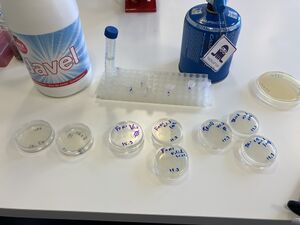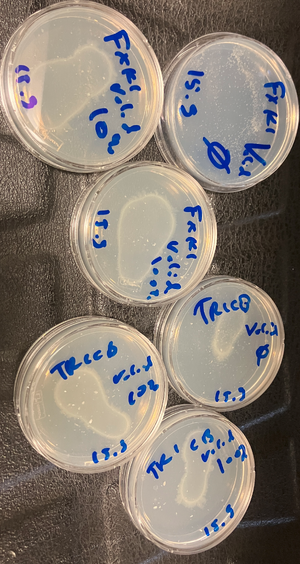Worm validations
English version
Here is the link to the French version.
This page is a simplified summary, concerning the validation of the standard operating procedure (SOP) used to inactivate genetically modified organisms (GMOs) with bleach, for use on nematode worms.
Part one of a validation experiment
Part two of a validation experiment
For this experiment, initial worm cultures of two different GMO worm strains, both carrying a marker gene that makes the worms 'Roll' (actually a mutated collagen gene, termed rol-6, on a plasmid with an antibiotic resistance marker) were grown to starvation for one week, and then washed off plates with water.
Here is a 3-second 'live' video of 'Roller' worms from one of these starved plates, before being washed.
The liquid containing the worms was distributed to three individual tubes and treated under three conditions: just in water, in 10% bleach or in 100% bleach.
The image to the right shows one part of the experiment.
In the image on the left are shown the secondary worm plates after treatments, 3 days after the treatments.
Without bleach, the numerous 'FXKI' strain nematodes have eaten all their food (top right), and although the bacterial layer is still clearly visible for the TR1CB strain, without bleach there are many worms.
After treatments with 10% or 100% bleach, only one plate, with the strain TR1CB, treated with 10% bleach, still had a few live nematodes.
All plates were inactivated according to the SOP after the third day of observation, as usual, with undiluted bleach (2.5% hypochlorite).
An important message to take away from the worm validation tests: resistant larvae (in the 'dauer' stage) can survive 10% bleach, but 100% bleach used according to the SOP on culture plates kills all stages of C. elegans nematodes...
This validation is part of our updates and revisions of the lab biosafety procedures.
Here is the similar validation for the case of GMO bacteria.
*
To note: The titles of many our wiki pages are not always perfect, but the content can be improved by everyone, too. This is the idea of the open science approach - to 'Do-It-Together'. =)

